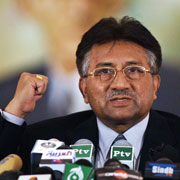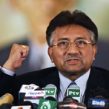Pakistan Loses Swat to Local Taliban
Publication: Terrorism Focus Volume: 4 Issue: 37
By:

In recent weeks large swathes of Pakistan’s idyllic mountainous region of Swat—a mere 90 miles from Islamabad—have fallen to militants purportedly led by Maulana Fazlullah, whose Tehreek-e-Nafaz-e-Shari’at-e-Mohammad (Movement for the Enforcement of Islamic Laws, or TNSM) shaheen (fighters) may number as many as 4,500. Swat’s residents are fleeing to safer ground as the security forces, largely comprised of the poorly trained and under-equipped Frontier Corps, are no match for Fazlullah and his following of belligerents. With Swat and other areas increasingly in the hands of militants, Pakistanis must rise to the challenge of combating an ideology that is fast encroaching into more settled areas.
Romanticized notions of Swat notwithstanding, several factors made this region—like Chitral—vulnerable to Talibanization. Swat has always been religiously conservative, with some parts of it influenced by the Jamaat-e-Islami (JI), which has many ideological commonalities with the Muslim Brotherhood. Other areas are inclined towards the Deobandi political party, Jamiat-ul-Ulama-i-Islam (JUI). The TNSM group of militants, which originated in Malakand, has also entrenched itself within Swat over the last eight years.
Maulana Sufi Mohammad, an active leader in JI throughout the 1980s, founded TNSM in the early 1990s and demanded the enforcement of Shari’a law contemporaneous with the rise of the Taliban. With the October 2001 launch of U.S. Operation Enduring Freedom, Sufi Mohammad dispatched thousands of fighters to support the Taliban against the United States and Northern Alliance, most of whom were killed, soundly defeated or captured. Sufi Mohammad was arrested, disgraced and blamed for the ignominious rout of the locals. After his imprisonment, his son-in-law Fazlullah took over the organization. Famous for his FM radio broadcasts, Fazlullah became known as “Maulana Radio” and spread the message of Islamization and pro-Taliban ideology. TNSM then used the 2005 earthquake to reposition itself and revive the movement (Terrorism Focus, May 17, 2006; Guardian, November 5).
The March 2004 military operations in South Waziristan spurred local militants to call themselves Pakistani Taliban and to establish independent administrations enforcing variants of Shari’a throughout Waziristan. As the Pakistani armed forces—mostly Frontier Corps augmented by elements of the army’s 11th Corps—intensified their operations in the tribal areas, Pashtun resistance increasingly became a pro-Taliban Islamist movement, quickly spreading to settled areas adjacent to Waziristan and beyond. Following a series of U.S. assaults on targets in Bajaur in January and October 2006, Talibanization has engulfed nearly every tribal agency as well as several settled districts in the North-West Frontier Province, including Swat, Chitral, Peshawar, Mardan, Charsadda, Mansehra, Malakand and Dir among others. Even the capital itself has not been spared (The Herald, July). In June 2007, Pakistan’s National Security Council met to discuss the evolving threat posed by Talibanization throughout the country (The Herald, July).
In Swat, the activities of Fazlullah and his followers intensified following the Lal Masjid (Red Mosque) siege in July. Fazlullah’s men launched a crusade against film and music venues, television broadcasts, girls’ schools, national and international charities and barbers who prune men’s beards. Recently, they derailed a government-sponsored polio vaccination program, captured a cleric opposed to them and seized public buildings, including police stations. In September, Swat’s Buddhist heritage came under attack for the first time when militants assaulted an important 23-feet tall Buddha statue in the valley. Failing to inflict damage, local Taliban mustered a second attempt in early November with well-placed explosives, destroying the statue’s head, shoulders and feet (ANI, November 6).
Equally disconcerting, but perhaps explaining in some measure the new brutality witnessed in Swat, are the reports of foreign militants joining Fazlullah. As North and South Waziristan have witnessed intense fighting, many foreign fighters have moved to safer areas, including Swat. Fighters from Uzbekistan and Afghanistan among others reportedly have joined Fazlullah’s forces—a claim denied by Fazlullah. Locals claim that the foreigners perpetrated the recent beheadings of four troops (Daily Times, November 7).
Despite knowledge of these developments, the government was slow to respond. Local officials are rumored to be either ambivalent or even sympathetic to the militants. The local administrator was replaced in October under a hail of allegations that he aided the fighters. The main religious parties, JI and the JUI have been loath to confront Fazlullah, as they both fight for influence in the region and fear alienating potential supporters.
In July, the government dispatched the first group of army and paramilitary troops to patrol the region, though these proved to be easily intimidated and thus ineffective. After more than two months, on October 24, four detachments of the Frontier Corps were sent in as reinforcements. This force comprised some 3,000 personnel, including 16 platoons of the Frontier Constabulary and six platoons of the Frontier Reserve Police (The Dawn, October 25). One day later, a suicide attack in Mingora killed at least 17 troops and four civilians (Reuters UK, October 28). Two days after that, the heads of two paramilitary soldiers were paraded through the streets of Matta with a stern warning that the men were allies of the United States and that other traitors would suffer a similar fate (New York Times, November 2)
Since the October 24 deployment, more than 200 men from the Frontier Corps (and possibly some from the Frontier Constabulary) have surrendered to the militants. The morale of the armed forces in Swat and elsewhere is low due to abduction, beheading of captive troops, increasingly sanguinary and brazen suicide attacks, deals with the militants, decisive military defeats and the demoralizing task of fighting one’s own citizens. These difficulties have resulted in numerous troop defections and many paramilitary and military personnel choosing to leave service. The evacuation of the government and incapacity of the security forces have left the population in Swat and elsewhere vulnerable to ravages of the militants and fearful of swift airborne assaults by an ever-more humiliated army.
On November 3, President Pervez Musharraf declared martial law, ostensibly to help fight terrorism. While lawyers, opposition party members, and human rights activists were arrested, Musharraf’s government released more than two dozen Islamists from jail. Reportedly, among those released was Mullah Obaidullah Akhund—the highest ranking Taliban official captured by Pakistani forces. Obaidullah was arrested in February 2007, coincident with U.S. Vice President Cheney’s visit to Pakistan to protest Pakistani insouciance towards the Taliban. In exchange for releasing these important Taliban operatives, Pakistani Taliban leader Baitullah Mehsud agreed to release the last of the 211 surviving troops taken hostage in Waziristan in late August (Newsweek, November 9). With the under-equipped and ill-prepared security forces already demoralized by a war that pits them against their fellow countrymen and in many cases against co-ethnics and fellow tribesmen, Musharraf’s actions are not likely to foster confidence and morale amongst his military. Yet this is exactly what is needed if Pakistani forces are to rally to the cause of tackling the Taliban.




